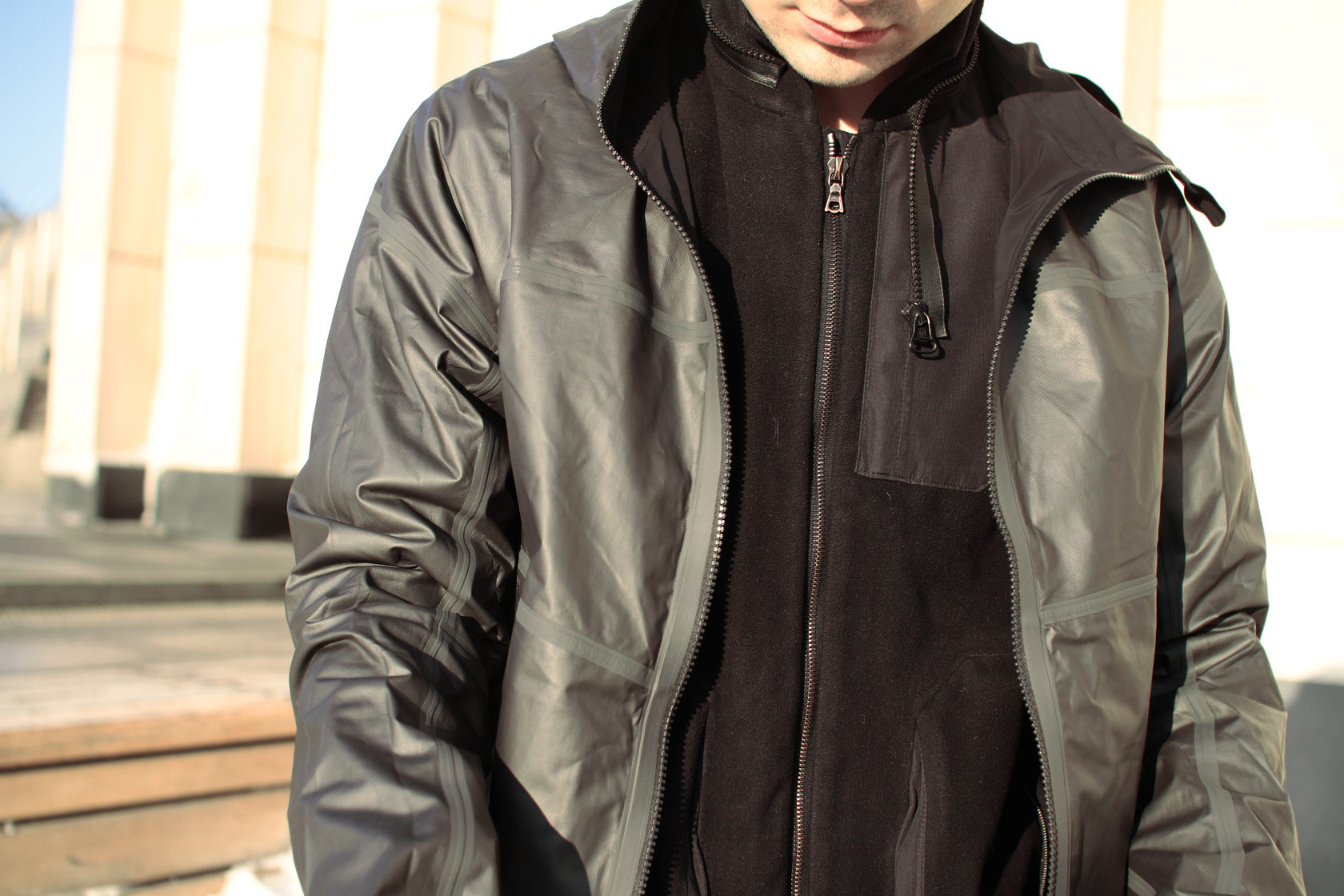VOLLEBAK'S MOST INNOVATIVE JACKETS [GRAPHENE JACKET]

VOLLEBAK'S MOST INNOVATIVE JACKETS
[GRAPHENE JACKET]
[GRAPHENE JACKET]
At the first announcement of the jacket made of graphene by experts from VOLLEBAK, it has generated as much noise as nothing previously released by the brand. Even for us it was hard to believe that there was produced a method that will allow you to implement already hard-extracted material in a structure for wearable garments. But after the company opened the veil of sensation, we realized : the world will never be the same.
By the end of last year we had a chance to see and even test the jacket live. Frankly speaking, it is difficult to believe that in hands there is a the Nobel prize winner-material, so rare and unique, besides integrated into clothes. We made a detailed photoshoot of the jacket in the field and "laboratory" conditions, and also asked Steve Tidball, co-founder of the VOLLEBAK about this phenomenon and work with it.
Interview/article: Alexander Zabelin [TECHUNTER, chief editor].
Answers: Steve Tidball [VOLLEBAK, founder].
Photo: Ivan Dzhatiev [TECHUNTER Media].
Special thanks for the jacket to Gwen Tran Sauvageot.
Answers: Steve Tidball [VOLLEBAK, founder].
Photo: Ivan Dzhatiev [TECHUNTER Media].
Special thanks for the jacket to Gwen Tran Sauvageot.
Graphene is the first known true two-dimensional crystal. It can be represented as a single plane of graphite separated from the bulk crystal. It is estimated that graphene has a high mechanical stiffness and record high thermal conductivity. In 2010, Russian scientists A. K. Geim and K. S. Novoselov were awarded the Nobel prize in physics for "advanced experiments with the two-dimensional material – graphene". They are the first scientists who managed to get it in the laboratory way.
While it's completely invisible and only a single atom thick, graphene is the lightest, strongest, most conductive material ever discovered, and has the same potential to change life on Earth as stone, bronze and iron once did. Graphene is simply the thinnest possible layer of graphite, the stuff used to make pencils.
While it's completely invisible and only a single atom thick, graphene is the lightest, strongest, most conductive material ever discovered, and has the same potential to change life on Earth as stone, bronze and iron once did. Graphene is simply the thinnest possible layer of graphite, the stuff used to make pencils.
When graphite is reduced to a single layer of carbon atoms arranged in a hexagon formation, it turns into a supermaterial unlike anything ever known before – it's so strong and so stretchy that the fibres of a spider web coated in graphene could catch a falling plane.
While graphene's existence was first theorised in the 1940s, it wasn't until 2004 that two maverick scientists, Andre Geim and Konstantin Novoselov, were able to isolate and test it. Through highly speculative and unfunded experimentation known as their 'Friday night experiments,' they peeled layer after layer off a shaving of graphite using Scotch tape until they produced a sample of graphene just one atom thick. After similarly leftfield thinking won Geim the 2000 Ig Nobel prize for levitating frogs using magnets, the pair won the Nobel prize in 2010 for the isolation of graphene.
While graphene's existence was first theorised in the 1940s, it wasn't until 2004 that two maverick scientists, Andre Geim and Konstantin Novoselov, were able to isolate and test it. Through highly speculative and unfunded experimentation known as their 'Friday night experiments,' they peeled layer after layer off a shaving of graphite using Scotch tape until they produced a sample of graphene just one atom thick. After similarly leftfield thinking won Geim the 2000 Ig Nobel prize for levitating frogs using magnets, the pair won the Nobel prize in 2010 for the isolation of graphene.
[What feedback did you already have after the first release of Graphene Jacket? How does the material behave in the field?]
What's so amazing is that people's willingness and ability to experiment with the material is as amazing as the material itself. We've had people floating in lakes in it, taking it apart in material labs, trying to hack it, as well as taking it to almost every corner of the globe. The most interesting stories have actually come from people using it to keep themselves alive, or protected in the most unexpected situations. When you put out an experiment like this, you never think of someone's life hanging on it.
It's hard to experiment with something that only behaves one way, so we made the jacket fully reversible, so there is no inside or outside. One side is coated entirely in graphene. The other isn't. The graphene side looks gun-metal grey. The non-graphene side is matt black and made from high-strength, high-stretch nylon. Depending on which way around you wear it and what you do in it, the jacket will interact with your body and the world around it in a series of different ways. The first step to creating this jacket involves turning raw graphite into graphene nanoplatelets. These small stacks of graphene are blended with polyurethane to create an incredibly thin membrane, which is then bonded to nylon to create an entirely new material.
Adding graphene to the nylon fundamentally changes its mechanical and chemical properties – a nylon fabric that couldn't naturally conduct heat or energy for instance, now can. And as graphene is only one atom thick, you can do this without adding a single gram of weight.
Every panel of the Graphene Jacket is cut with lasers - the material is so expensive wasting it is not an option. And both pockets are laser cut with such precision that we've been able to leave the edges raw with zero stitching. All the panels are then bonded together and the seams sealed for waterproofness.
Every panel of the Graphene Jacket is cut with lasers - the material is so expensive wasting it is not an option. And both pockets are laser cut with such precision that we've been able to leave the edges raw with zero stitching. All the panels are then bonded together and the seams sealed for waterproofness.

[Graphene as the material was isolated and tested by Andre Geim and Konstantin Novoselov, British scientists of Russian origin. Did you work with the scientists or contact them on any advices on the work with Graphene?]
We were hugely inspired by the work of Geim and Novoselov, particularly their Friday Night Projects where they specifically experimented with stuff well outside their field. It's their vision of experimentation that we wanted to bring to our own work with graphene – the idea that you don't have to be a world-renowned expert in a field to do something new or interesting in it. And the fact that being so ingrained in a single subject can even be a barrier to doing something totally new because you almost know too much. It was one of the key reasons that we wanted to open up the testing process of the Graphene Jacket early to our customers, before we had all the answers ourselves.
One of the first prototypes of the Graphene Jacket was so highly conductive you could attach a power source at one end, a light bulb at the other and it would light up. Having debated how useful or dangerous that would be, we decided to increase the material's resistance to electrical currents, by spreading out the graphene nanoplatelets. This first edition of the Graphene Jacket still conducts electricity, but at a far lower and safe level.
Graphene conducts heat better than any material on Earth. So when you're wearing the jacket with the graphene side next to your body in cold weather it helps equalise your skin temperature by sending heat from the hot bits of your body like your head, to the cold bits like your hands. It's the first wave of conductive fabrics that will carry heat or electricity around your body but without any power source. Lab tests have shown that the closer to your body the material is, the more effective it will be at regulating your skin temperature and increasing it by an average of 2°C.
In 2014 physicists at the Max Planck Institute revealed that graphene challenges the fundamental laws of heat conduction. While the amount of heat a material can conduct was believed to stay constant whatever size or shape it was, the conductivity of graphene increases the more graphene there is, which means that it can theoretically absorb an unlimited amount of heat.
Graphene conducts heat better than any material on Earth. So when you're wearing the jacket with the graphene side next to your body in cold weather it helps equalise your skin temperature by sending heat from the hot bits of your body like your head, to the cold bits like your hands. It's the first wave of conductive fabrics that will carry heat or electricity around your body but without any power source. Lab tests have shown that the closer to your body the material is, the more effective it will be at regulating your skin temperature and increasing it by an average of 2°C.
In 2014 physicists at the Max Planck Institute revealed that graphene challenges the fundamental laws of heat conduction. While the amount of heat a material can conduct was believed to stay constant whatever size or shape it was, the conductivity of graphene increases the more graphene there is, which means that it can theoretically absorb an unlimited amount of heat.
But as the nylon base material has a melting point of 200–300°C, this should be tested carefully. You can heat the jacket up by leaving it out in the sun or over a radiator with the graphene side exposed to the heat source. If you then turn it inside out and wear the graphene next to your skin it acts like a radiator, retaining its heat and spreading it around your body.
While wearing the graphene next to your body will keep you warmer by increasing your skin temperature, it will also create less humidity next to your body than a normal membrane. In lab tests the humidity was consistently lower during every phase of exercise and recovery, so you should feel less hot and sweaty. It's believed that the graphene is somehow able to disperse the extra humidity from the heat, but the 'how' remains unknown for now.
As it's only a single atom thick, graphene increases the strength of the jacket in all abrasion and puncture tests, and it does it without adding a single gram of weight. But as much as we want it to be, it's not bulletproof yet. Theoretically you need 10 layers of graphene to stop a bullet and the tech isn't there yet. When it is, we'll be the first trying to make a lightweight suit of extreme sports armour. In the meantime we'll take the strength benefits of a single graphene layer of this early stage technology.
While wearing the graphene next to your body will keep you warmer by increasing your skin temperature, it will also create less humidity next to your body than a normal membrane. In lab tests the humidity was consistently lower during every phase of exercise and recovery, so you should feel less hot and sweaty. It's believed that the graphene is somehow able to disperse the extra humidity from the heat, but the 'how' remains unknown for now.
As it's only a single atom thick, graphene increases the strength of the jacket in all abrasion and puncture tests, and it does it without adding a single gram of weight. But as much as we want it to be, it's not bulletproof yet. Theoretically you need 10 layers of graphene to stop a bullet and the tech isn't there yet. When it is, we'll be the first trying to make a lightweight suit of extreme sports armour. In the meantime we'll take the strength benefits of a single graphene layer of this early stage technology.

[Even if it is part jacket part science experiment now, tell us its advantages and disadvantages on using Graphene jacket in everyday life or active wear? Do you think it will be the next innovative materials to use for production run?]
I think over the next 10 years, the opportunities that lie in graphene beat any other material that we currently know about. The question really is how quickly it can move from incredibly experimental to incredibly useful. This is precisely what we are working on. In everyday life at the moment we know of two people where the jacket's heat-retaining properties have made a difference to them in potentially life-threatening situations – one in a desert overnight, and another in Mongolia where the guy was lost in a snowstorm. We are still learning what it can do from the stories coming back from the first version of the jacket
Graphene's tight atomic bonds make it impermeable to nearly all gases and liquids. But water molecules are the one exception. Which means we've been able to make the jacket both breathable and waterproof. As you sweat it's able to evaporate out through graphene. And at the same time the polyurethane membrane makes it waterproof to 10,000mm. For the best combination of waterproofness and breathability, wearing it with the graphene on the inside produces the best test results.
While the graphene membrane has a slightly rubberised feel, the black side of the jacket is soft and smooth. It's made from a lightweight Italian-made matt black nylon that's strong, windproof, lightweight and mixed with 15% elastane so that every part of the jacket stretches. With welded eyelets under the arms, laser cut and bonded cuffs, elastic drawcords on the hood and waist and articulated sleeves designed for training, the fit is more like a lightweight running jacket than a ski shell.
While the graphene membrane has a slightly rubberised feel, the black side of the jacket is soft and smooth. It's made from a lightweight Italian-made matt black nylon that's strong, windproof, lightweight and mixed with 15% elastane so that every part of the jacket stretches. With welded eyelets under the arms, laser cut and bonded cuffs, elastic drawcords on the hood and waist and articulated sleeves designed for training, the fit is more like a lightweight running jacket than a ski shell.
When you train you sweat. This sweat impregnates your clothes and contains bacteria that quickly makes your clothes smell. Unlike normal clothing, graphene is inherently bacteriostatic, which means bacteria can't grow or reproduce on its surface and the jacket won't smell like your normal kit. As well as being bacteriostatic, the graphene membrane is also known to be hypoallergenic and anti-static, and is certified as non-toxic.
14 years after its discovery, graphene remains extremely difficult to work with, incredibly expensive to produce, and very hard to make in large quantities. And while it's been around since the beginning of time, it's only a few billion years later that we can even think about designing materials with it. But like any new technology the industry around it will only mature over the next 10 to 100 years. Silicon was discovered by a Swedish chemist in 1824, but it took nearly a century before silicon semiconductors paved the way for the rise of computers.
14 years after its discovery, graphene remains extremely difficult to work with, incredibly expensive to produce, and very hard to make in large quantities. And while it's been around since the beginning of time, it's only a few billion years later that we can even think about designing materials with it. But like any new technology the industry around it will only mature over the next 10 to 100 years. Silicon was discovered by a Swedish chemist in 1824, but it took nearly a century before silicon semiconductors paved the way for the rise of computers.
“
"The next 1,000 years might be the Carbon Age. Our view is that wearable technology will become increasingly invisible over the next 10 to 20 years. Instead of wearing it over your eyes or on your wrist, it will be embedded as clothing and tech simply merge. Graphene's ability to conduct heat and power and withstand insane forces, while adding zero mass, should make it central to the story. It's a supermaterial with the same potential to change life on Earth as stone, bronze and iron once did. The earlier we start the journey, the faster we get to the future." – VOLLEBAK.
Read our previous parts of
VOLLEBAK'S MOST INNOVATIVE JACKETS:
SOLAR CHARGED JACKET
BLACK SQUID JACKET
100 YEAR HOODIE
VOLLEBAK'S MOST INNOVATIVE JACKETS:
SOLAR CHARGED JACKET
BLACK SQUID JACKET
100 YEAR HOODIE
Graphene jacket by VOLLEBAK is available for purchase here.
You can read our other interviews with Steve in TECHUNTER 04 printed issue, representing the company in general and the latest TECHUNTER 06 ONLINE digital issue, where Steve shared with us his thoughts on the future of the industry after pandemic. Issues are available in our store.
You can read our other interviews with Steve in TECHUNTER 04 printed issue, representing the company in general and the latest TECHUNTER 06 ONLINE digital issue, where Steve shared with us his thoughts on the future of the industry after pandemic. Issues are available in our store.



